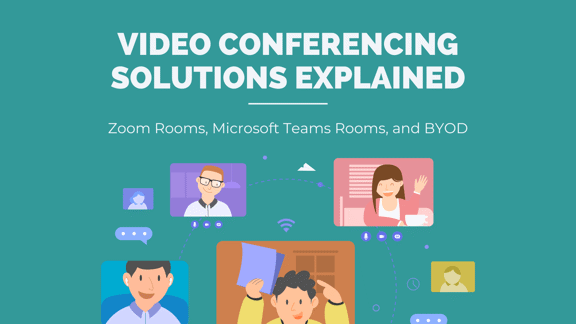Video Conferencing Solutions Explained: Zoom Rooms, Microsoft Teams Rooms, and BYOD
Zoom Rooms, Microsoft Teams Rooms, and other video conferencing solutions are redefining the future of business. In this insightful piece, we analyze these technologies, their unique offerings, and their powerful role in a rapidly evolving market. Read on to stay ahead of the curve in workplace communication.
Introduction
Video calls used to be a cool, high-tech idea, but now they're as ordinary as sending a text message. In the early days, we had to plan extra time to deal with connectivity issues and ensure everyone knew how to use the technology. But today, people want quick and easy meetings without the fuss.
Video conferencing tools like Zoom and Microsoft Teams became crucial during the pandemic. They didn't just help us work from home; they also made office workers more productive and satisfied, increasing employee retention. It's hard to imagine going back to a time without video calls. Nearly a third of all workers prefer working from home than going to the office. So, it's clear that video conferencing is a necessity for modern businesses.
The Video Conferencing Market

Video calling has changed a lot in recent years. After a significant rise in use from 2019 to 2022, it's still growing steadily. The market, including the software and the equipment for video calls, is expected to grow by over 12% yearly. The past few years have shown how video calls have gone from a niche tool to a standard solution for all business sectors.
At first, businesses started using video calls more as an emergency response to the pandemic. However, companies soon realized that video conferencing had numerous benefits: increased productivity, reduced travel costs, and more flexibility.
The Normalization of Video Conferencing

The pandemic sparked a significant shift in how we view video calls, and what was a cool, innovative tech tool is now a standard part of business communication. This change happened quickly due to lockdowns and social distancing, but changes within organizations and new ways of working remotely also contributed to this trend.
New developments in video call software have made a considerable difference to the user experience. We've gone from blurry screens to fully interactive communication systems. Video calls can now break down communication barriers, boost productivity, and help teams collaborate, no matter where they are. They're no longer just a standard tool but a driving force assisting businesses to rethink their work.
Established Video Conferencing Solutions
The video conferencing market has brought about many changes in how companies and employees organize meetings. Let’s have a look at some of the most popular video conferencing solutions, including Microsoft Teams Rooms (MTR), Zoom Rooms, and Bring Your Own Device (BYOD). These solutions are reshaping how employers and employees connect, share information, and conduct business across distances. Each category represents a unique approach to integrating technology and collaboration tools, catering to different user needs and organizational structures.
What are Microsoft Teams Rooms (MTR)?
Microsoft Teams Rooms (MTR) are physical spaces designed to foster enhanced team collaboration. They integrate Microsoft Teams - a team collaboration software - with the necessary audio-visual (AV) hardware, including the best webcams for video conferencing, creating a unified meeting environment.
With over half a million installations globally, MTRs are widely used, serving over 280 million users monthly. These rooms provide a comprehensive meeting experience, bringing high-definition (HD) video, audio, and content sharing to meetings of all sizes - from small huddle areas to large conference rooms.
MTRs are characterized by a user-friendly interface allowing you to connect to meetings with a single touch, experiencing natural visual and audio interfaces and document sharing. Key components of an MTR include:
- A touchscreen console
- Computer module
- MTR application
- Peripheral devices (camera, microphone, speaker)
- External screens, such as an interactive display
- HDMI input
Microsoft ensures a high-quality experience by maintaining a tightly controlled list of certified systems and peripherals for MTRs.
What is a Zoom Room?
A Zoom Room is a software-based room system that provides an integrated experience for audio conferencing, wireless screen sharing, and video conferencing. Developed by Zoom - the most popular video conferencing technology in North America - Zoom Rooms offer a bundle of certified services and products. The technology is designed to deliver an experience that prioritizes high-definition (HD) video and audio, one-touch meetings, wireless sharing, and cross-platform compatibility.
Zoom Rooms are scalable and can be configured for various environments, from home offices to large conference rooms, highlighting their versatility and widespread appeal. Key features of Zoom Rooms include:
- HD Video and Audio: This feature guarantees high-definition video and audio quality, providing a clear and crisp communication experience that closely mimics in-person meetings.
- One-Touch Joining of Scheduled Meetings: This functionality allows participants to join pre-scheduled meetings with a single click or tap, simplifying access and reducing potentially wasted time on technical issues.
- Wireless Sharing: This refers to the ability to share content from your device onto the screen during a meeting without the need for cables or a complex setup. It promotes the seamless sharing of presentations, documents, or other visual resources.
- Interoperability: This aspect ensures that Zoom Rooms can be accessed and used efficiently across various devices and operating systems. It supports inclusivity and flexibility, allowing participants to join the meeting from their preferred devices.
What does Bring Your Own Device (BYOD) mean?
Bring Your Own Device (BYOD) refers to a policy where employees use their devices, such as smartphones, tablets, laptops, and USB drives to carry out their work, connect to their organization's network, and access work-related resources. This policy has gained significant traction recently due to its clear advantages.
With BYOD, employees can work more efficiently using familiar devices, which provides flexibility to support remote and flexible working arrangements. Other key advantages of BYOD include the following:
- Familiarity: Employees are often more comfortable and efficient using their own devices.
- Flexibility: BYOD policies support remote work and flexible working arrangements.
- Cost Savings: Organizations can reduce their hardware costs as they do not need to invest in purchasing and maintaining a large fleet of devices.
- Efficiency: Employees can customize their workspaces and choose the applications they're most productive with.
- Employee Satisfaction: BYOD policies can contribute to higher levels of employee satisfaction.
As the BYOD trend grows, organizations must establish clear guidelines and robust security measures to protect sensitive data and ensure network security.
Upgrade Your Video Conferencing with i3TOUCH ULTRA
i3TOUCH ULTRA enhances your Zoom and Microsoft Teams Rooms meetings with its ultra-wide, interactive display.
Boost team collaboration, productivity, and engagement all in one easy-to-use system.
What Does the Future Hold for Video Conferencing?
Video calls have become essential to our work lives, and there's much potential for further enhancements. With the rise of hybrid workplaces combining remote and on-site work, the need for robust video call solutions is becoming increasingly important. As home offices and personal studios become more common, individuals seek to boost their video call quality, leading to new products in the market.
Despite this evolution, maintaining team connectivity remains critical. Innovative applications of video calls are emerging, mirroring the experience of physical workplaces. These allow for spontaneous interactions with remote colleagues, simulating the serendipitous exchanges we associate with office environments. Technological advancements also contribute to a more engaging video call experience, with live video editing and personalized features such as avatars and custom backgrounds on the rise. We might even see features drawn from augmented reality, virtual reality, and gaming becoming fundamental elements of video calls in the future.

Regarding market dynamics, the global video conferencing software market size was valued at USD 11.9 billion in 2021. According to Straits Research, it is projected to surge to USD 78.62 billion by 2030, growing at a compound annual growth rate (CAGR) of 26.5% during the forecast period from 2022 to 2030.
One of the persisting challenges with standard video calls is their tendency to be dominated by one individual. New tools are being developed to enhance the content quality of video calls and the overall user experience. Solutions that support real collaboration, equitable participation, and the comparison of multiple inputs are transforming video calls to feel more akin to face-to-face meetings. These improvements are expected to spur further growth and adoption in the industry, resulting in more engaging and productive virtual interactions.
The video call market is continuously growing and diversifying. With the increasing acceptance of remote work and consistent tech enhancements, it's evident that video calls are not just here to stay. They will continue to evolve, shaping the future of workplace communication and collaboration.
Conclusion
Regardless of where teams work or how they access the technology, the world has moved decisively toward communicating via videoconferencing. In K-12 education, commercial organizations, health care, higher education, and all levels of government rely on this key tool to cooperate, learn, grow, and perform. We all retain visual information at a higher rate than that which is only written.
Ultimately, no single videoconference platform or setup works in all settings and for everyone. Application knowledge drives specification: who will use it, in what setting, for how long, and what will be done with the technology. The good news is that the technology has advanced in each design discussed here to provide outstanding experiences for users. i3-Technologies' interactive touchscreens lead the way in supporting each design. A level of performance maturity has crossed paths with affordability to help make this work tool ubiquitous – available for everyone.
Frequently Asked Questions about Video Conferencing Solutions
What are Microsoft Teams Rooms (MTR)?
Microsoft Teams Rooms (MTR) are physical spaces that integrate Microsoft Teams software with audio-visual hardware for team collaboration. They include components like a touchscreen console, computer module, MTR application, and peripheral devices.
What is a Zoom Room?
A Zoom Room is a software-based system providing an integrated experience for audio conferencing, wireless screen sharing, and video conferencing. It features high-definition video and audio, one-touch meetings, and cross-platform compatibility.
What does Bring Your Own Device (BYOD) mean in a business context?
BYOD refers to a policy where employees use their own devices for work. This approach increases familiarity and flexibility, brings cost savings, improves efficiency, and often leads to higher employee satisfaction.
How has the video conferencing market grown and what is its projected growth?
The video conferencing market was valued at USD 11.9 billion in 2021 and is expected to grow to USD 78.62 billion by 2030, at a CAGR of 26.5%.
How do video conferencing tools impact productivity in the context of remote work?
Video conferencing tools like Zoom and Microsoft Teams have increased productivity, reduced travel costs, and provided more flexibility, thereby enhancing employee satisfaction and retention.

